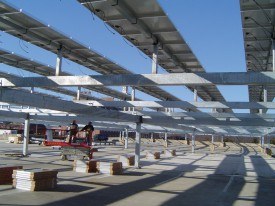HDG Performance Benefits
Why Galvanized Steel is the Solution
Structures throughout the power market can benefit from the use of hot-dip galvanizing (HDG). Most power structures, whether for generation, transmission, or distribution, are designed for a life of 50 years or more. These structures are also often subjected to varied environments, many of which can be highly corrosive. All structures throughout the power grid have a need for durable, abrasion-resistant, long-lasting protection.

Reliability (Proven Performance)
HDG has been used throughout the power grid for generations. As the makeup of generation transitions, hot-dip galvanizing has remained the coating of choice on many structures. Not only was hot-dip galvanizing used extensively in coal, nuclear, and natural gas facilities, but it is also commonly used in renewable generation. Beyond generation, hot-dip galvanizing is used extensively in transmission structures. The heavy use in these “interstates” of power has helped an aging grid stay viable. Particularly in generation and transmission structures, hot-dip galvanizing provides cost-effective protection, often initially and over the long-term reducing downtime and maintenance costs.
Resiliency
Steel has a high strength-to-weight ratio which provides a number of benefits. It allows for longer spans without a pole and can stop cascading of the line in severe events. Steel poles are often used in higher voltage transmission lines for these reasons, but it is becoming more common to see steel distribution poles – particularly in increments to “harden” the line or in areas where longer span lengths are necessary.
Recyclability
Steel has the highest recycled content (93%) of any building material, and it also boasts a 98% reclamation rate (i.e. 98% of steel available for recycling is in fact recycled). In addition to the high recycled content and reclamation rate, it is important to understand that unlike many materials that are down-cycled into a lesser product, steel is multi-cycled which means it can be recycled over and over again without the loss of chemical/physical properties, making it a true cradle-to-cradle material.